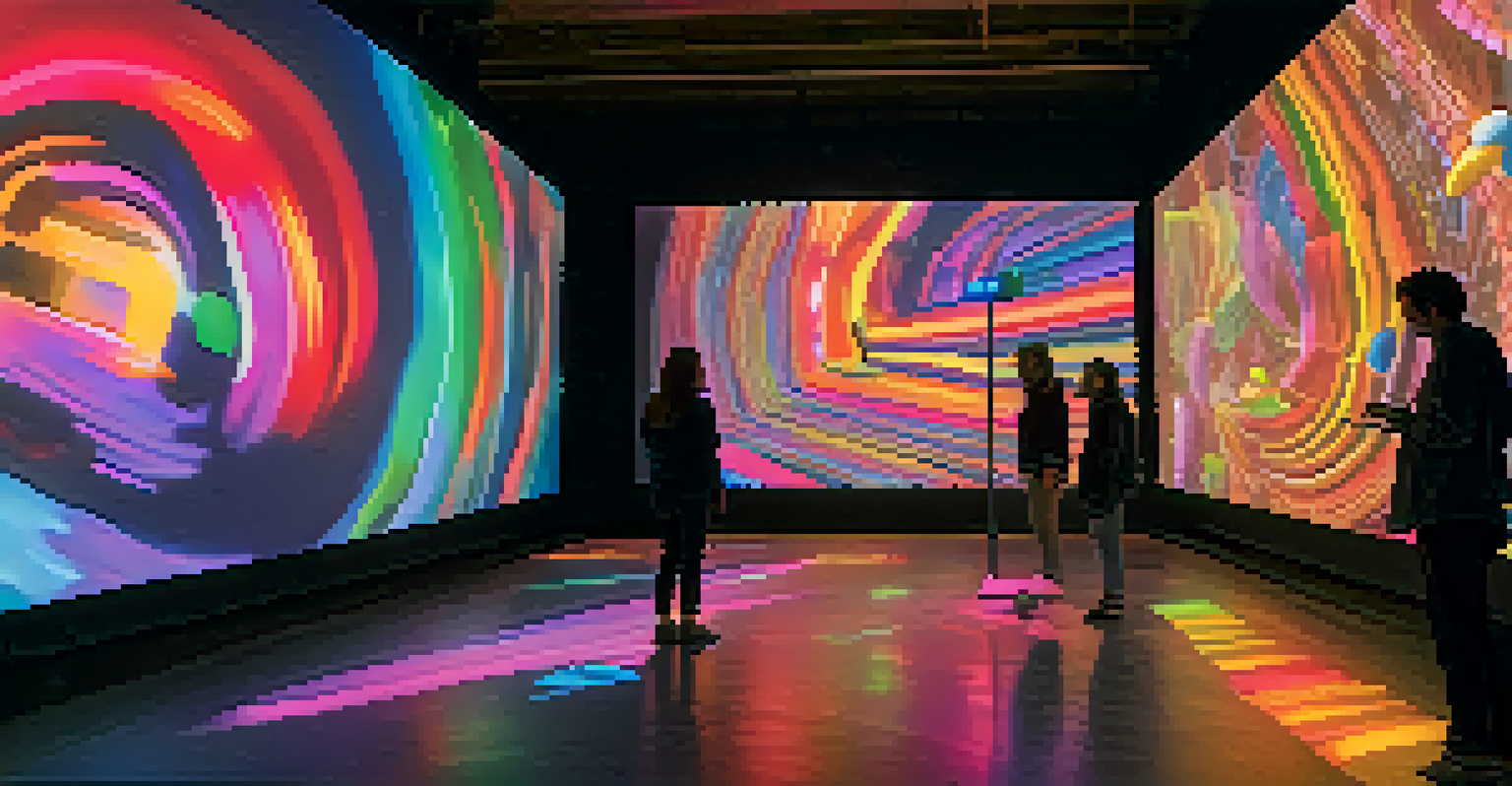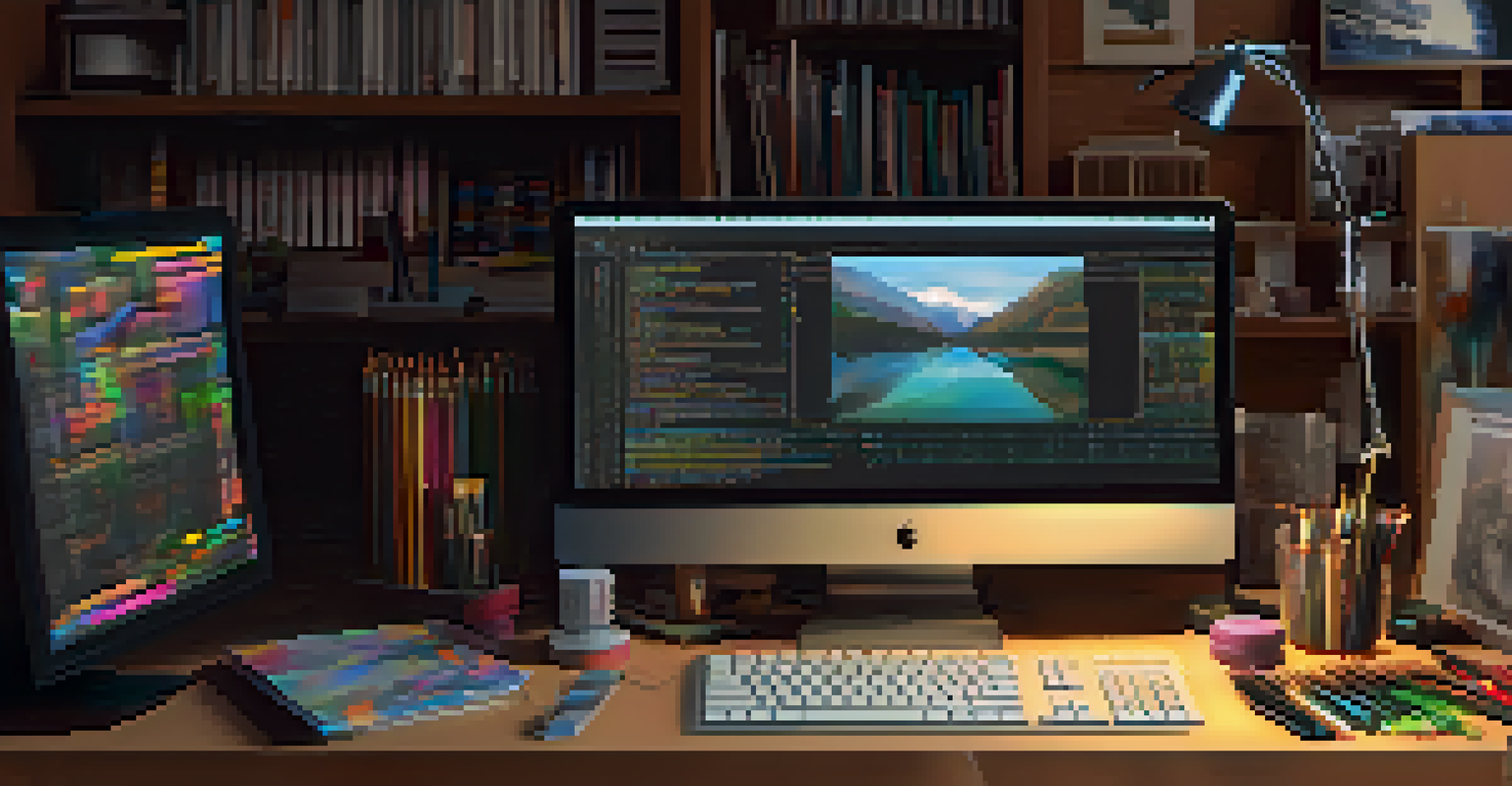The Impact of Open Source Tools on Creative Coding Communities

Understanding Open Source Tools in Creative Coding
Open source tools are software programs that anyone can use, modify, and share. This concept has revolutionized how creative coders approach their projects, allowing for collaboration and innovation without the burden of expensive licenses. By using open source tools, creators can focus more on their craft and less on the financial constraints that often accompany proprietary software. This democratization of technology fosters a vibrant community where ideas can flow freely.
Open source is a development methodology; it doesn't just mean access to the source code. It means a community of developers sharing their experiences and knowledge with each other.
For instance, platforms like Processing and p5.js are excellent examples of open source tools tailored for artists and designers. They provide a user-friendly interface that simplifies coding, making it accessible for those who may not have a traditional programming background. This accessibility not only attracts seasoned coders but also inspires novices to dive into the world of creative coding, ultimately enriching the community.
The collaborative nature of open source projects means that anyone can contribute, whether through code, documentation, or tutorials. This collective effort leads to continuous improvements and updates, ensuring that the tools stay relevant and useful. As a result, creative coding communities thrive on this shared knowledge, pushing the boundaries of what is possible in digital art.
Fostering Collaboration Among Coders and Artists
One of the most significant impacts of open source tools is the collaboration they encourage among artists and coders. Traditionally, these two groups operated in silos, but open source projects create a bridge for creative exchange. When artists can modify code to suit their vision, the lines between coding and artistry blur, leading to truly unique creations.

Take the example of the open source software OpenFrameworks, which allows artists to create interactive installations using code. By collaborating with developers, artists can push their projects further than they could alone. This synergy not only enhances the final product but also enriches both parties' skills and perspectives.
Open Source Tools Enhance Creativity
Open source tools democratize access to powerful software, allowing creators to focus on their art without financial constraints.
Moreover, the collaborative spirit often extends beyond just coding. Many open source communities host workshops, hackathons, and online forums where members can share ideas and learn from one another. This environment fosters a sense of belonging, encouraging individuals to experiment and innovate without the fear of judgment.
Enhancing Accessibility to Creative Coding Resources
Accessibility is a crucial factor in fostering creativity, and open source tools play a significant role in this. Unlike proprietary software, which may come with hefty price tags, open source options are typically free or very low-cost. This enables a wider audience to access powerful tools that would otherwise be out of reach, leveling the playing field for aspiring creators.
The great thing about open source is that you can take it, modify it, and use it in ways that were never intended. It’s not just about the software; it’s about the community and the collaboration.
For instance, software like GIMP and Blender offers professional-grade features without the associated costs of commercial programs. This opens up opportunities for students, hobbyists, and emerging artists to explore their creative potential without financial barriers. The ability to use high-quality tools can be the difference between a budding interest and a full-fledged career in creative coding.
Furthermore, open source projects often come with extensive documentation and community support, making the learning curve less steep. Beginners can find tutorials, forums, and other resources to help them navigate the world of coding. This supportive atmosphere encourages experimentation, leading to innovative projects that might not have emerged in a more restrictive environment.
Driving Innovation Through Shared Knowledge
Innovation thrives in environments where knowledge is shared freely, and open source tools facilitate this process remarkably well. When creators have access to a wealth of resources and can learn from one another’s experiences, they are more likely to take risks and explore new ideas. This shared knowledge base can lead to breakthroughs in creative coding that might not have been possible in isolated settings.
Consider how the open source community around Arduino has led to a surge in interactive art installations. By sharing code and project ideas, artists can build upon each other's work, creating something greater than the sum of its parts. This collaborative innovation is a hallmark of successful creative coding communities, driving trends and pushing the boundaries of what’s possible.
Collaboration Drives Innovation
The collaborative nature of open source projects fosters a creative exchange between artists and coders, leading to unique and innovative creations.
Moreover, as projects evolve, they often inspire new ones. An artist might take an existing open source project and add their unique twist, sparking further creativity. This cycle of sharing and innovation keeps the community dynamic and constantly evolving, ensuring that creative coding remains a vibrant field.
Building Stronger Creative Communities
Open source tools don’t just impact individual projects; they also play a vital role in building strong creative communities. By encouraging collaboration and shared learning, these tools help forge connections among artists, developers, and designers. This sense of community can be incredibly empowering, fostering a culture of support and encouragement.
Take, for example, local meetups or online groups centered around open source tools. These gatherings provide spaces for individuals to share their work, seek feedback, and collaborate on projects. Such interactions can lead to lasting friendships and partnerships, creating a network of creatives who inspire and uplift each other.
Additionally, when communities rally around a specific open source tool, they often contribute to its development and improvement. This active participation strengthens the tool and deepens the community’s investment in its success. As members see their contributions make a real impact, it fosters a sense of pride and ownership, further solidifying the community's bonds.
The Role of Open Source in Education and Learning
Open source tools have become invaluable in educational settings, particularly in teaching creative coding. Schools and universities are increasingly incorporating these tools into their curricula, providing students with hands-on experience in coding and digital art. This practical approach not only enhances learning but also prepares students for the demands of the creative industry.
For example, platforms like Scratch allow students to learn programming concepts through engaging, visual interfaces. By using open source tools, educators can introduce complex ideas in a way that is accessible and enjoyable for learners. This not only enhances their understanding but also sparks interest in further exploration of coding and creativity.
Supportive Communities Empower Growth
Open source tools help build strong creative communities that encourage shared learning, collaboration, and a sense of belonging among members.
Moreover, open source communities often provide resources specifically designed for educators, including lesson plans, tutorials, and project ideas. This wealth of material makes it easier for teachers to integrate coding into their classrooms. As more students become proficient in coding through these open source tools, the future of creative coding looks brighter than ever.
Challenges and Limitations of Open Source in Creative Coding
While the benefits of open source tools in creative coding are substantial, it's essential to acknowledge some challenges and limitations. For instance, not all open source projects are equally maintained or supported, leading to inconsistencies in quality. Creators may encounter outdated resources or lack of documentation, which can hinder their progress and creativity.
Additionally, the open nature of these tools can sometimes result in a steep learning curve for newcomers. Without proper guidance, beginners may feel overwhelmed by the sheer volume of information available, making it difficult to get started. This challenge highlights the importance of community support and mentorship in helping newcomers navigate the landscape.

Lastly, the reliance on open source tools may sometimes lead to a lack of originality, as many creators may end up using similar resources and ideas. While collaboration is essential, it’s also crucial for individuals to find their unique voice and style. Balancing the use of open source tools with personal creativity is key to fostering innovation in the creative coding community.